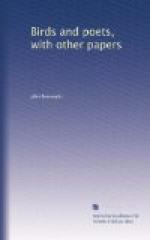In the same poem the poet asks:—
“Can trouble live with April days?”
Yet they are not all jubilant chords that this season awakens. Occasionally there is an undertone of vague longing and sadness, akin to that which one experiences in autumn. Hope for a moment assumes the attitude of memory and stands with reverted look. The haze, that in spring as well as in fall sometimes descends and envelops all things, has in it in some way the sentiment of music, of melody, and awakens pensive thoughts. Elizabeth Akers, in her “April,” has recognized and fully expressed this feeling. I give the first and last stanzas:—
“The strange, sweet days
are here again,
The happy-mournful days;
The songs which trembled on our lips
Are half complaint, half praise.
“Swing, robin, on the
budded sprays,
And sing your blithest tune;—
Help us across these homesick days
Into the joy of June!”
This poet has also given a touch of spring in her “March,” which, however, should be written “April” in the New England climate:—
“The brown buds thicken
on the trees,
Unbound, the free streams sing,
As March leads forth across the leas
The wild and windy spring.
“Where in the fields the
melted snow
Leaves hollows warm and wet,
Ere many days will sweetly blow
The first blue violet.”
But on the whole the poets have not been eminently successful in depicting spring. The humid season, with its tender, melting blue sky, its fresh, earthy smells, its new furrow, its few simple signs and awakenings here and there, and its strange feeling of unrest,— how difficult to put its charms into words! None of the so-called pastoral poets have succeeded in doing it. That is the best part of spring which escapes a direct and matter-of-fact description of her. There is more of spring in a line or two of Chaucer and Spenser than in the elaborate portraits of her by Thomson or Pope, because the former had spring in their hearts, and the latter only in their inkhorns. Nearly all Shakespeare’s songs are spring songs,—full of the banter, the frolic, and the love-making of the early season. What an unloosed current, too, of joy and fresh new life and appetite in Burns!
In spring everything has such a margin! there are such spaces of silence! The influences are at work underground. Our delight is in a few things. The drying road is enough; a single wild flower, the note of the first bird, the partridge drumming in the April woods, the restless herds, the sheep steering for the uplands, the cow lowing in the highway or hiding her calf in the bushes, the first fires, the smoke going up through the shining atmosphere, from the burning of rubbish in gardens and old fields,—each of these simple things fills the breast with yearning and delight, for they are tokens of the spring. The best spring poems have this singleness and sparseness. Listen to Solomon: “For lo, the winter is past, the rain is over and gone; the flowers appear on the earth; the time of the singing of birds is come, and the voice of the turtle is heard in the land.” In Wordsworth are some things that breathe the air of spring. These lines, written in early spring, afford a good specimen:—




